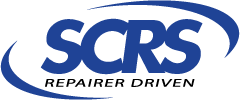History of SCRS
The beginning of shops coming together to help other shops – working together to become an association that would one day be ‘Repairer Driven’.
The Society of Collision Repair Specialists (SCRS) was founded in Riverside, Missouri in 1982. At the associations onset, the phrase “Working Together Is The Most Important Work We Do” was recognized as a hallmark of the Society of Collision Repair Specialists (SCRS, the Society). Truth be told, the theme of repair facility unification infused the organization from the start.
The collision repair industry in the decade before the birth of SCRS – the 1970s – was different in many ways, notably its fragmentation. “Practically every shop was an independent,” recalls Iva Dehn, who along with her husband Fred, witnessed the birth of the Society. “That may sound good today, but in practice it wasn’t. Shops looked at each other with suspicion; each convinced their competition was out to take food off their family’s table.”
With communication next to non-existent, the trade consisted largely of strangers with each facility an island unto itself. Not a great model even in a stable market, and as the decade came to a close, signs began to surface indicating imminent industry upheaval. It wasn’t just advancements in technology, such as the introduction of the unibody vehicle. The new vehicle structures, together with advancements in refinish materials and a lack of industry-accepted training, caused perceptive shop owners to feel as if certain market dynamics were wrestling away control of their businesses.
“There wasn’t a collective industry voice, and that left the industry vulnerable,” states Past SCRS Chairman Bill Eveland, also a participant in the formation of the Society. “In fact, when some of us in the Kansas City area began to throw around the idea with other like-minded individuals of forming a group that would help us improve as collision professionals, some repairers feared retaliation.”
Despite their apprehension, their conviction grew, and the feeling that the industry had to do something. Then it was only a matter of time until the right catalyst kick-started the movement toward a national organization solely dedicated to collision repair.
Dehn continues, “Fred and I attended a meeting in North Kansas City, and at that meeting a man stood up. This gentleman was neat, clean and he wore a suit. He spoke with knowledge, power, wit and humor. He said that the person across the table was neither demon nor monster, that he or she was a body shop person just like us. Suddenly, it became obvious we had a better chance of solving some of our problems if we worked together. Later that evening with the meeting over, we all stood out in the parking lot even after it began to rain, and really talked to each other for the first time. That night’s speaker was none other than John Loftus. He had already made a difference in our lives.”
Rochelle Wicklund, who also attended that meeting with her husband Past SCRS Chairman Bill Wicklund, likewise recalls the dramatic effect Loftus had on the crowd. “My husband Bill and I—as well as Bill Eveland and the rest of those in attendance—felt that John was the man that could put a face on the type of group we had discussed. He talked about cleaning up our shops and having professional offices. It was evident that he knew what we were going through and what needed to be done to change our industry. It wasn’t long before we had another meeting, this time at Gene Parks’ Body Shop in Riverside, Missouri.”
“I’m not certain of the precise sequence of events,” adds Eveland, “but by the time we met at Gene Parks’, a group of us had talked a bit and a loose agenda had been put together.” That night at Gene Parks’ was a fateful one. Cars were moved back in the stalls and the floor was swept clean. Folding chairs were brought in to form a semi-circle in the middle of the shop and the anxious owners and technicians milled together. A side door opened, and John Loftus stepped through. After a round of hand shakes, the group got down to business. Though the details had yet to be worked out, those in attendance knew they wanted to form a group and that John needed to lead it.
“We realized we needed numbers if we really wanted to effect change,” explains Dehn, “and to do that we had to reach out to at least every shop in the Kansas City area. We discussed it some more, and John informed us that there were others beyond our local horizon that had the same thirst to reach out and join with others. The fire really started to burn in us then, as we began to ponder the possibilities that might come with the creation of a true national body shop association.” That was the beginning of shops coming together to help other shops—the beginning of ‘Working Together’ to become an association that would one day be ‘Repairer Driven.’
Past Chairpersons
1982 – 1984
1984 – 1985
1985 – 1986
1986 – 1987
1987 – 1988
1988 – 1989
1989 – 1990
1990 – 1992
1992 – 1993
1993 – 1994
1994 – 1995
1995 – 1996
1996 – 1997
1997 – 1998
1998 – 1999
1999 – 2000
2000 – 2001
2001 – 2002
2002 – 2003
2003 – 2005
2005 – 2007
2007 – 2008
2008 – 2009
2009 – 2011
2011 – 2013
2013-2015
2015-2017
2017-2019
2019-2021
2021-2023














